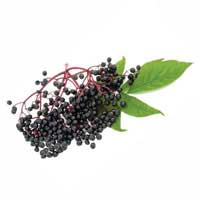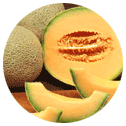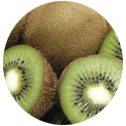 Full List of Fruits
Full List of Fruits  American Black Elderberry
American Black ElderberryAmerican Black Elderberry
![]() Introduction of American Black Elderberry
Introduction of American Black Elderberry
Scientific name - Sambucus nigra
Native to most of Europe, Elderberries grows 10 to 12 feet tall and wide. This purple black fruit is used in pies, wines, jellies, jams, juices and soup. Having said that, they are one of the easiest and most versatile shrubs to cultivate in your edible landscape!American Black Elderberry (Sambucus Canadensis) is a deciduous shrub native to North America. It is a member of the Adoxaceae family and can grow up to 10 feet tall. The flowers are small, white and fragrant and the berries are dark purple to black in color.
Elderberry also known as Sambucus is from the family of Adoxaceae, which is a genus of flowering plant. Formerly placed in the honeysuckle family, the fruits when ripe are blackish purple in color and globose in shape. With seeds just about 3mm long, they are globular in shape and about 4 mm diameter, calyx persistent at the apex.American Black Elderberry is a popular plant for attracting beneficial insects such as bees and butterflies, and for its medicinal and culinary uses. It is a great addition to any garden and can provide year-round interest and beauty.
The juice of elderberry was used in treating flu. With so much of medicinal properties they are also used in wine making and jelly preparation. Following are some of the components present in Sambucus and it includes:
 Tannin
Tannin
 Amino acids
Amino acids
 Carotenoids
Carotenoids
 Flavonoids
Flavonoids
 Rutin
Rutin
 Viburnic acid
Viburnic acid
 Vitamin A and B and
Vitamin A and B and
 Large amount of vitamin C
Large amount of vitamin C
![]() Nutritional Value of American Black Elderberry
Nutritional Value of American Black Elderberry
| Calories 73 | Calories from Fat 4 |
| % Daily Value* | |
| Total Fat 0g | 1% |
| Saturated Fat 0g | 0% |
| Trans Fat 0g | |
| Cholesterol | 0% |
| Sodium | 0% |
| Total Carbohydrate | 6% |
| Dietary Fiber 7g | 28% |
| Sugars 0g | |
| Protein | |
| Vitamin A 12% , Vitamin C 4% | |
| Calcium 4% , Iron 9% | |
![]() Health Benefits of American Black Elderberry
Health Benefits of American Black Elderberry
There are several uses in an elderberry; its antioxidant activity helps to
Reduce Heart Disease.
Treat wounds.
Cure eye inflammation.
Lower cholesterol.
Improve vision.
Boost the immune systems.
Tonsillitis.
Bacterial and viral infections .
![]() Uses of American Black Elderberry
Uses of American Black Elderberry
The elderberry's distinctive dark blue-black berries have been used for centuries in Europe to make wines, liqueurs, jams, jellies and other recipes. They are also used to make teas and syrups that are believed to have antiviral and anti-inflammatory benefits. The berries contain a number of compounds including anthocyanins, which are powerful antioxidants that may help protect cells from damage.
Elderberry is also used in traditional medicine for its purported anti-inflammatory and anti-viral properties. Studies have shown that elderberry extracts inhibit the growth of certain bacteria and viruses, including influenza. Additionally, elderberry may help reduce symptoms of upper respiratory tract infections, such as coughing, sore throat and congestion.It is also used in cosmetics and skincare products. The berries contain flavonoids, which are believed to have antioxidant properties that may help protect the skin from damage. Additionally, elderberry may help reduce the appearance of wrinkles and improve skin tone and texture.


















